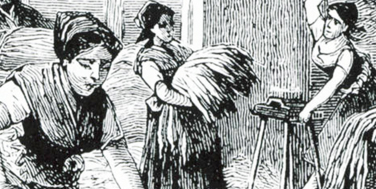Where do they come from, all the small, everyday things like twine, cords and thread? The many ropes in different strengths and shapes, the yarns from which we make nets and weave shoe laces? Should these cords and ribbons be raw, bleached or even dyed? The new Topotheque in Golling an der Erlauf allows us to take a look at the immense complexity and ancient expertise, where the “First Austrian Hemp Spinning and Twine Factory” was built 150 years ago, which determined the life of the community for generations. You can get a vivid impression of the variety on offer in this photo where the rope makers present their goods. In addition to the technology and products, the focus of this Topotheque is also on social life, which had to exist here as an industrial island in a rural region. The buildings of the “Farbrikssiedlung”, where the workers lived, that still exist today have provided the backdrop of this photographs over the decades, in front of which people have spent and spend their everyday lives. A consumer association was founded here early on, and its simple but ultra-modern building with its impressive inscription can be seen in a number of pictures.
Another architectural gem is the combination of the municipal office and cinema, both of which are still preserved and are at least worth a virtual visit, which we especially recommend it to those who could not attend the opening. The opening of the Topotheque took place here in the cinema, which ceased operations in the 1970s and is being restored by volunteers. Original wall panels, carpets, terrazzo floors, doors, letters, seats and lights were a uniquely atmospheric framework that accompanied the images of the past with their historical color. Mayor Alois Kammerer opened the collection for the more of 100 visitors, Alexander Schatek spoke introductory words about the nature of the Topotheque and the Topothequers Johann Periny and Manfred Zwirner presented a selection of the photos. Larissa Popov, Richard Horal, Max Muster and Friedrich Grabner were available to answer detailed questions afterwards. With a buffet and bar tables under a blossoming chestnut tree, the atmosphere was probably similar to that of coming to the cinema in 1960 on a Lohner scooter.
The Topotheque, which already contains over 2,000 entries, for which Topothequer Manfred Zwirner has also opened his extensive collection, offers not only the pictures but also a great verbal treasure. Many regional terms or terms associated with the industry of flax extraction (our cover photo) and processing, such as Biadl hocken (chopping brushwood), cardery, short fibers, hackle and swing tow, hackle machine, are immortalized and illustrated with pictures.
Finding the content in this new Topotheque, which takes us up to the 100th anniversary celebrations last year, is supported by the extensive lists of topics with which you can come across some content that you probably would not have discovered on your own. Visit the polishing room or the hemp magazine and be fascinated by this collection that is not just about industrial history!
 Breaking and panting: the work that played such a big role in the history of the community is described here in detail © Scan: Manfred Zwirner
Breaking and panting: the work that played such a big role in the history of the community is described here in detail © Scan: Manfred Zwirner